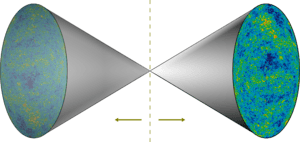Baryon asymmetry facts for kids
The universe we live in is full of matter. Everything around us, from tiny atoms to giant stars, is made of matter. But did you know there's also something called antimatter? Scientists believe that when the universe began, the Big Bang should have created equal amounts of matter and antimatter. However, today, almost everything we see is matter. This big puzzle, known as the baryon asymmetry problem, is one of the greatest mysteries in physics.
Contents
What is Matter?
Matter is what makes up everything you can touch, see, and feel. It's made of tiny particles like protons, neutrons, and electrons. For example, your body, the air you breathe, and the Earth itself are all made of matter.
What is Antimatter?
Antimatter is like a mirror image of regular matter. It has particles that are similar to matter particles but with opposite charges. For instance, an electron has a negative charge, but its antimatter partner, a positron, has a positive charge. If matter and antimatter meet, they destroy each other in a flash of energy. This is called annihilation.
The Big Bang and the Missing Antimatter
Scientists believe the universe started with a massive explosion called the Big Bang. According to our best theories, the Big Bang should have created matter and antimatter in perfectly equal amounts. Imagine making a cake and always having exactly the same amount of flour and sugar.
So, if equal amounts were made, where did all the antimatter go? If matter and antimatter met, they would have wiped each other out, leaving nothing behind. But clearly, our universe exists, and it's full of matter! This means there must have been a tiny bit more matter than antimatter right after the Big Bang.
The Great Mystery
This small difference, where matter somehow won out over antimatter, is the baryon asymmetry problem. Scientists don't yet have a full explanation for why this happened. It's like a cosmic riddle: why is there so much matter and so little antimatter in the universe we observe?
This mystery suggests that some of the laws of physics might have acted differently for matter and antimatter in the very early universe. Finding the answer could help us understand how the universe came to be and why we exist. It's an exciting area of research for physicists around the world.
See also
 In Spanish: Asimetría de bariones para niños
In Spanish: Asimetría de bariones para niños


